BP Tinkering Journal: Background to Experiment...
BP Tinkering Journal: Background to Experiment...
Hi Folks - I'd promised to update you with photos for the purpose of my future (next week's) experiment... so I figured it's worth a little background in order to convey the context of the installation. Here it all is:
Somewhere back in 2008 I'd planned out an upgrade project for one of my existing clients. In the end the project didn't go through due to combined financial factors. However, the key point here is that the project got me thinking about creating a multifaceted filtration system that can be adapted to multiple, if not all potential (freshwater and marine) aquarium [water processing] solutions within a single adaptable facility. Since the original plan in 2008 failed to launch into a real-life project; I continued to develop that initial multi-solution concept into an actual reproduce-able (patent-pending) filtration system.
Although this is not the place (thread) to elaborate on the actual filtration system I figured a little background would be appropriate to explain the pellet setup and weird looking reactors you might be questioning in the following photos...
So the answer to the inevitable query...
"what type of reactors are you using...?" ...they are prototypes.
Here are the photos:
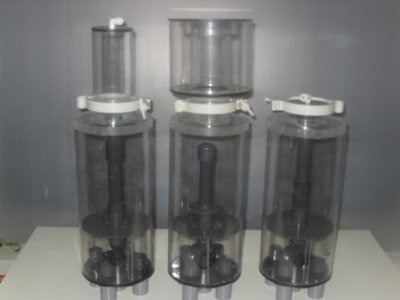
The reactors have standard base portions and necks; that can be fitted with interchangeable heads. So far, I've made a 'tall-head' for the reactor on the left that will function as a calcium reactor; a 'skimmer-head' for the reactor in the middle for obvious function (also the middle insert is flipped to allow the foam through); and a 'flat-head' for the reactor on the right that will function as a [fluidized] media reactor.
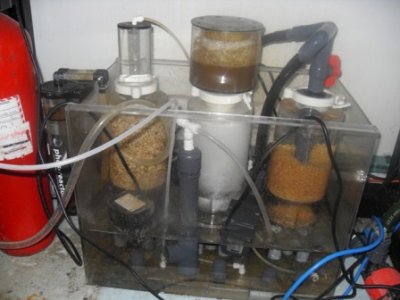
After a few weeks of operation, and a gradual build up from 1L to 2.5L of pellets, I noticed that the pellets were making their way through the bottom diffuser plate into the base of the reactor. And since the media was being fluidized from just above the diffuser plate, the bottom of the reactor was a stagnant spot for the pellets to be sitting.
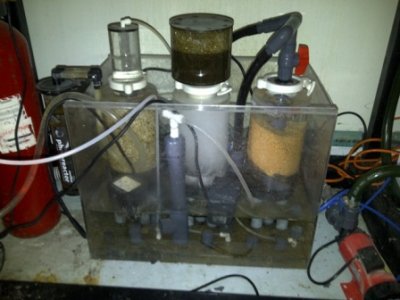
My first instinct was to try to prevent this by introducing some window screen (mesh) to sit on the bottom diffuser plate in the hopes that the pellets would be contained above the plate. This ultimately didn't work as the pellets would eventually make their way underneath the mesh, and continue to fill the bottom space after about a week of operation.
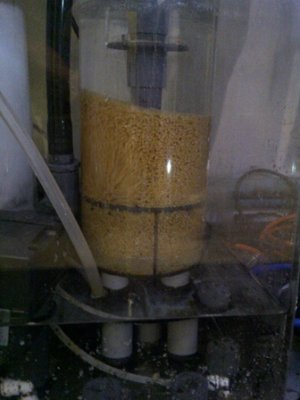
Eventually, I decided that the mesh was a band-aid solution and not a desirable one at that. It also occurred to me that if the bottom (4") space could be made useful without the risk of allowing an anaerobic micro-environment to take hold within the reactor, there would be a potential of increasing the overall capacity of the reactor, without having the new problem of media overflowing through the exit at the top. So one of the plugs were modified to allow some of the water pressure in from below the diffuser plate with the hope of eliminating this potential of a dead-zone. All of the water still exits the reactor at the top, which means that fresh water is always fed through the bottom trapped media. This also allowed for an additional 1L of pellets to be added bringing the introduced media to 3.5L, but I would assume that approximately .5L would have already been consumed over the past 3-4 months of operation.
The hope with this last arrangement is that the bottom media will function similar to the setup that some have with the pellets in a media bag, i.e. not tumbling; while the media above the plate will continue to tumble in a conventional manner. It can be also seen from the picture above that the media above the plate is moving quite a lot while the portion below appears to be simply resting.
Below is a pic of the foam being generated by the 'foam reactor' aka protein skimmer:
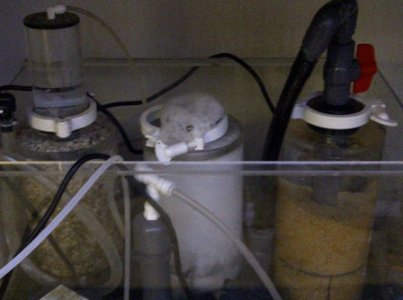
I'd mentioned in one of my last posts that I wanted to adjust the pump to recirculate a significant portion of the water within the reactor in order to slightly lower the O2 level in the reaction chamber to see if the anaerobic component will increase and positively boost the entire process, but after reading the post about the ease of potential for these pellets to go anoxic, I think it might be wise to wait until that potential is ruled out in the current arrangement of relaxed flow through the bottom. So far after about 3-4 days running there is no sign of H2S at the bottom.
I did another water test today, and it is still hard to tell how much the nitrates are coming down as I'm trying to judge between the dark shades of red indicative of API's range of 40ppm to 160ppm. In the three days that the new arrangement has been in action it looks as though the reading might in fact be budging downward, but I can't say for sure. The colour is taking longer to darken if that is any indication; however, I am optimistic that there should be a clearer indication within a week or two, so I'll keep you posted and hold off on the pump adjustment til then.
Sorry about the essay. Please feel free to let me know if my flow presumptions are completely misplaced. Thanks for reading if you managed to make it through all...! It took me about 3 days to assemble everything and type it:spin2:
Regards,
Sheldon
 However, I agree with you banker. I don't think anyone knows exactly how they work.
However, I agree with you banker. I don't think anyone knows exactly how they work. 








